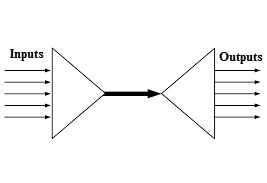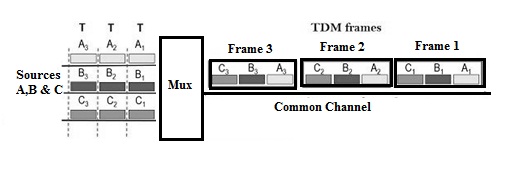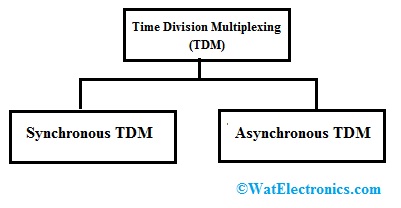Multiplexing is a method used to merge & transmit multiple data streams over a particular medium. In telecommunications, the multiplexing technique are extensively used where numerous telephone calls are carried throughout a single wire. This concept originated in the early 1870s in telegraphy and then the telephone carrier multiplexing was developed in 1910 by George Owen Squier later followed by different types of multiplexing. Some of the types of multiplexing techniques available are frequency division, time division, wavelength division, code division, polarisation division. Among them, this article discusses on TDM or time-division multiplexing that was developed by Bell Labs in the 1950s.
What is Time Division Multiplexing?
Time-division multiplexing is a term that has been used in the technology world for many years. It’s a method of transmitting multiple data streams over a single transmission channel by interleaving pieces of each stream at different times. In other words, it takes information from two or more sources and combines them into one signal that can be sent over the same line.

Time Division Multiplexing
So, by using this multiplexing, we can add additional channels to the digital circuit by sharing the circuit with other digital signals. This multiplexing process is used in dividing the time portions of the signal into smaller fractions and transferring them to different locations in the network.
For example, Do you think you are using a Time Division Multiplexing in your home network—and the answer is yes you are!—it is your router and modem working together to divide up the line into segments of time. Each segment of time will be assigned to a specific device in your home. That way, when one device sends data over the internet, it can send it all at once, but it will wait until its own segment of time before it does so. It’s almost like little devices taking turns on a playground.
Please refer to this link to know more about Time Division Multiplexing MCQs
Theory of TDM
Time Division Multiplexing, or TDM for short, is a method for sending multiple signals through the same physical channel. This can be done in a variety of ways . For For a better understanding of the TDM concept, let us discuss the following time-division multiplexing circuit.
We know that the multiplexing technique allows the different signals transmitted over a common channel. But, one may require distinguishing between the different signals for suitable transmission of data. As a result, in TDM, the transmission of the complete signal can be done by occupying various time slots. Generally, TDM can be performed to multiplex several data signals.
In the following diagram, different sources like A, B & C want to send data using a common medium. So the signal from these sources can be separated into different frames where each frame has a fixed time slot.

Time Division Multiplexing Working
Here three units from every source can be taken into consideration that equally forms the genuine signal.
A-frame can be transmitted at a time that is collected with one unit for every source. Once these units are completely dissimilar as compared to others then the probability of needless signal mixing can be removed.
Once a frame gets broadcasted over the specific time slot, then the next frame utilizes a similar channel to get broadcasted. Further, the procedure is repeated until the achievement of the transmission.
In the above example, we have taken three different sources, however, one can achieve n-source signals multiplexing.
It is important here that single source units should be equal to the whole number of source signals to be broadcasted. By using TDM, the multiplexing of both the analog and digital signals can be done however its processing method simply allows the digital signals multiplexing easily instead of analog signals.
Types of TDM
There are two main types of time-division multiplexing synchronous and asynchronous:

Types of TDM
Synchronous TDM
Whenever a computer is sending more information than can fit into a single packet, it has to split its data up. For example, if you’re trying to download a file from a website and the website is taking too long to send all the files down, your computer will have to send several packets in order to get everything. This was an annoying problem before computers existed (it was called “being human”), so we already had a solution long before we became cyborgs: synchronous time-division multiplexing.
Synchronous time division multiplexing is a form of time-division multiplexing that allows the transmission and reception of signals over the same medium. This method is commonly used to speed up computer networks. Instead of having many data links between two points, it uses fewer links simultaneously by rearranging the data into a continuous stream of short frames or slots.
It means that you basically have to wait for each packet of information to arrive before continuing with the next one. So, if you’re downloading a file from a website and the site sends 3 packets at once, you’ll have to wait for the first one to arrive before downloading the second one.
With asynchronous time-division multiplexing, on the other hand, things work differently: instead of waiting for packets of information to arrive, each packet gets assigned a time slot and then they’re sent out in no particular order—so now when you’re downloading that 3-packet file, you can download all three packets at once because they’re not being sent back-to-back. The downside is that it takes longer for everything to happen.
Asynchronous TDM
Asynchronous time-division multiplexing (ATDM) is the form of multiplexing that allows you to perform tasks in parallel by being able to complete a given task in less time. This is made possible through the ability of each task to utilize the information that other tasks have completed. Whereas synchronous multiplexing requires tasks to be completed at the same time, ATDM allows a single processor to work on many different tasks simultaneously.
To understand it better let’s look into a real time scenario like the data transmission through a wifi network or phone etc, here TDM uses a single channel to transmit a single signal made up of many different pieces of information simultaneously—and that signal can only move as fast as its slowest piece of data.
The problem is that when the signal gets delayed or stopped in its tracks, everything is delayed or stopped entirely until the entire signal is sent again. So if your streaming service goes down for even a second… you miss an episode of your favourite series. In fact, all online content providers experience downtimes due to congestion on the networks they rely on—there’s simply too much data trying to fit through too small of a pipe.
This is where asynchronous time-division multiplexing comes in: it allows us to use multiple channels to transmit multiple signals simultaneously. Each channel can have its own speed, so delays are less likely to affect the whole system and content.
So far we came to know about time division multiplexing and it’s different types. Now let’s get to understand how to determine the efficiency of a TDM through the below example.
Time Division Multiplexing Example Problem
In TDM, if both the transmission & propagation delays of a packet is 2msec each at 5 Mbps bandwidth (BW), then calculate the following.
- Efficiency
- Effective Bandwidth
- How many highest stations can be allied to the network if every station needs 3 Kbps bandwidth?
Given data is,
Transmission delay or Tt is 2msec
Propagation delay (Tp) = 2msec
Bandwidth (BW) is 4 Mbps
Efficiency
The efficiency of a time division multiplexing can be calculated as
Efficiency (η) = 1 / 1+a; where a = Tp / Tt
For calculating the ‘a’ value; a = Tp / Tt
a = 2msec/2msec = 1; so, a = 1
Calculating Efficiency-
Efficiency (η) = 1 / (1+a) => 1 / (1 + 1) => 1 / 2 => 0.5 => 50%
Effective Bandwidth
The effective bandwidth of a TDM can be calculated as;
Effective Bandwidth = Efficiency x Bandwidth
So, effective bandwidth = 0.5 x 5 Mbps = 2.5 Mbps
Calculate How Many Stations are connected to the Network?
To calculate how many stations are connected to the network, this formula is used.
Maximum Effective BW = Total no. of stations x BW requirement of one station
Let the whole no. of connected stations be ‘N’, then
2.5 Mbps = N x 2 Kbps
N = 1500
Therefore, a maximum of 1500 stations can be connected to achieve a better understanding of TDM.
Differences between Time and Frequency Division Multiplexing
The difference between time division and frequency division multiplexing is discussed below.
|
Time Division Multiplexing |
Frequency Division Multiplexing |
| The acronym for time-division multiplexing is TDM. | The acronym for frequency division multiplexing is FDM. |
| TDM works through both analog and digital signals. | FDM works through only analog signals. |
| Time-division multiplexing is one of the most widely used types of digital signal transmission. | Frequency division multiplexing is also one of the most widely used types of digital signal transmission. |
| In Time Division Multiplexing, signals from different sources can be transmitted on a single cable or channel, one after another. In this case, the time is divided into slots (or frames) which are assigned to each source. | In Frequency Division Multiplexing, signals from different sources are transmitted over different frequency bands. Each carrier occupies its own unique band and is modulated by a low-frequency message signal. |
| TDM has less conflict. | FDM has high conflict. |
| In TDM, wiring is simple. | In FDM, wiring is complicated. |
| TDM is very efficient. | FDM is not efficient. |
| Time-sharing takes place in time-division multiplexing. | In frequency division multiplexing, frequency sharing takes place. |
| TDM requires synchronization pulse at the beginning of a frame to allow synchronization | FDM requires a guard band to divide the signals & avoid overlapping. |
| TDM is applicable in digital audio mixing systems, PCM (Pulse Code Modulation) optical fiber communication or optical data transmission system, etc. | FDM is used in first-generation mobile phones and also used for broadcasting AM & FM, used in TV networks. |
Advantages of TDM
The advantages of TDM include the following.
- It can deliver fast data;
- It can protect data from degradation;
- It can utilize expensive transmission lines better than most other methods;
- It works well with satellite communications.
- its ability to increase bandwidth. It does so by enabling several signals to be transmitted simultaneously over one wire or channel, which is far faster than sending them one at a time.
- it enables synchronization between devices, as well as ensuring that data from each device occurs in the same time slot. This allows for greater accuracy and precision when transferring information.
- It also makes troubleshooting easier because it makes certain failures very easy to identify and fix
- it reduces latency compared to other methods of signaling and multiplexing, such as time division multiple access (TDMA).
Disadvantages of TDM
The disadvantages of TDM include the following.
- A failure in one channel can cause the entire system to fail
- It’s more complex than other methods, so there’s more room for errors
- It is more vulnerable to noise than other forms of multiplexing. While baseband signals can travel long distances without encountering noise, bandpass signals are more prone to experiencing interference as they pass through a medium.
- It requires a complex and expensive regenerative repeater, which is used to regenerate the signal at each repeater.
- It takes time to switch from one channel to another
- When a signal drops out—say, because of an error—the entire stream also drops out, causing all signals to become unavailable until everything can resynchronize.
- Since each signal has its own timeslot, it’s important that the receiver knows when that timeslot starts and ends. This means that the receiver will need to be synchronized with the sender to properly decode all of the information. If they are out of sync, they won’t be able to tell where in the stream each piece of information starts and ends.
Applications of Time-division multiplexing
A common application of time-division multiplexing is in digital telephony. There are two main types of telephone lines: analog and digital. Analog lines use frequency-division multiplexing, where each signal is sent on its own frequency band. Digital lines use time-division multiplexing, where the signals are interleaved at different times to prevent them from interfering with each other.
Another common use for time-division multiplexing is Ethernet networks, which use this method to send data from one computer to another over a single line by interleaving packets of information at different times onto that line so they don’t interfere with each other when being transmitted simultaneously.
Thus, Time-division multiplexing is a technology that allows different signals to be transmitted at the same time over the same line. TDM is useful for boosting bandwidth to more than one application in a LAN. It can be implemented in several ways as it is used in LAN network for so many years and is on its way to becoming dominant as the technology of choice, due to its low cost and ease of implementation. Here is a question for you, what is FDM?